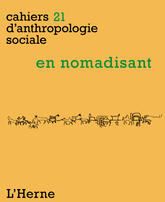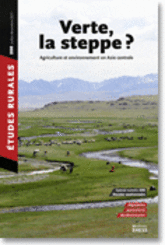Carole Ferret
Chargée de recherche CNRS, Enseignants ChercheursLaboratoire d'anthropologie sociale, 52 rue du Cardinal Lemoine, 75005 Paris
Tél : + 33 (0)1 44 27 18 86
Couriel : Carole Ferret
Présentation (English below)
Après quatre années passées sur le terrain, en Russie, Sibérie et Asie centrale, cinq années d’activité professionnelle dans les archives audiovisuelles documentaires russes et soviétiques, j’ai travaillé comme chercheur à l’Institut français d’études sur l’Asie centrale à Tachkent (Ouzbékistan) en 2008-2010, puis ai été recrutée au CNRS en 2010.
Mon projet de recherches est intitulé Traitement de la nature et traitement d'autrui. Une anthropologie de l'action chez deux peuples pasteurs d'Asie centrale et de Sibérie orientale. A partir d’une ethnographie des techniques d’élevage et de dressage des chevaux en Asie intérieure qui s’appuie sur plusieurs années de terrain réalisées en Asie centrale et Sibérie depuis la fin de l’URSS (Ferret 2006 ; Ferret 2009a), j’ai conçu une anthropologie de l’action, bâtie sur l’analyse des formes d’action, s’attachant à décrypter les modes opératoires employés, notamment dans le domaine technique. Pour élaborer cette grille d'analyse multidimensionnelle des actions humaines, je me suis inspirée des travaux d'A.-G. Haudricourt, des réflexions de la philosophie de l’action, de la linguistique, de la sociologie et de la technologie culturelle, ainsi que de mes propres observations de terrain.
Cette anthropologie de l’action est susceptible de s’appliquer dans les domaines les plus divers des activités humaines. Elle permet de mener une comparaison du traitement de la nature et du traitement d’autrui qui n’est pas liée à des jugements de valeur (traitement doux ou brutal, amical ou agressif des êtres naturels et humains), ni à des différences ontologiques (suivant que ces êtres sont ou non considérés comme similaires à soi), mais qui est fondée sur une analyse des caractéristiques formelles des actions : agit-t-on directement ou de manière détournée ? sur l’objet de l’action ou sur son milieu environnant ? de façon continue ou discontinue ? intervient-on vigoureusement sur le cours des choses ou laisse-t-on les choses se faire ? s’agit-il de faire ou de faire faire ? etc. (Ferret 2010f; Ferret 2012a ; Ferret 2014b). Cette démarche originale exige d’entrer dans les rouages techniques des actions. Elle est susceptible de révéler des correspondances formelles entre les techniques d’élevage du bétail et les manières de traiter autrui, telles qu'elles se manifestent dans les rapports homme-femme, adulte-enfant, aîné-cadet, dominant-dominé, colonisateur-colonisé.
Cette anthropologie de l’action permet d’analyser en détail le fonctionnement des actions humaines, ce que j’ai entrepris en comparant deux peuples turcophones, les Iakoutes (Sakha) en Sibérie orientale et les Kazakhs en Asie centrale. Elle pourrait éventuellement révéler des propensions pour certaines formes d’action, mais elle permet déjà de mieux les comprendre. L'exploration des rapports de l'homme et du cheval en Asie intérieure m’a amenée à aborder les thèmes les plus variés : physiologie du chaud et du froid (Ferret 2004, Ferret & Toqtabaev 2010, Ferret à paraître), usages alimentaires (Ferret 2010a), histoire de la colonisation (Ferret 2009b), droit coutumier (Aouelbekov et Ferret 2010), conception de l’identité ethnique (Ferret 2011b), transformations des jeux et des sports (Ferret 2008a, 2018e, Ferret & Noûs 2020), techniques pastorales (Ferret 2007, 2010c, 2017b), éducation des enfants (Ferret 2010f). J’ai largement utilisé cette méthodologie pour l’étude du pastoralisme en Asie centrale et septentrionale et de son évolution depuis la fin du XIXe siècle, avant, pendant et après l’expérience soviétique (Stépanoff & al. 2013, Ferret 2013a, 2016a, Elie & Ferret 2017, Ferret 2017b, 2018a), ainsi que pour l’analyse des relations entre hommes et animaux (Ferret 2016c, 2017a). L’étude de l’espace et du temps nomades centrasiatiques (Ferret 2005-6, 2014c, 2021a, 2023) m’a conduite à une réflexion sur les relations épistémologiques entre ethnologie et histoire (Ferret 2012b ; 2018a ; 2018b), ainsi qu’entre ethnologie et archéologie (Ferret 2014a ; 2019).
Thèmes de recherche
- anthropologie de l'action
- ethnographie des techniques
- ethnologie de l'éducation
- traitement de la nature et traitement d'autrui
- pastoralisme
Terrains
Depuis 1993, en Fédération de Russie, Sibérie (Iakoutie, Bouriatie, Khakassie, Touva) et Asie centrale (Kazakhstan, Kirghizstan, Ouzbékistan et Turkménistan), et plus particulièrement chez :
- Les Iakoutes (Sakha), en Sibérie orientale
- Les Kazakhs, en Asie centrale
Équipes (voir liens ci-joints)
- Relations humains-animaux : questions contemporaines
- Dynamiques relationnelles : parenté et socialité
Enseignements et séminaires
- « La technologie, une matière pour l'anthropologie et les sciences sociales » avec Thierry Bonnot et Flavia Carraro, EHESS
- « L’Asie centrale dans tous ses États : questions et méthodes », avec Isabelle Ohayon et Julien Thorez, EHESS
Activité éditoriale
- Membre du comité de rédaction et ancien rédacteur en chef des Cahiers d’Asie centrale
- Membre du comité de rédaction d'Etudes rurales
- Membre du comité de rédaction d'Anthropozoologica
- Membre du comité de rédaction d’Études mongoles et sibériennes, centrasiatiques et tibétaines
- Membre du comité de rédaction des Cahiers d’anthropologie sociale
Principales publications
Ouvrages
- 2017 codirigé avec Marc Elie, Verte, la steppe ? Agriculture et environnement en Asie centrale numéro 200 de la revue Études rurales, Paris, EHESS.
- 2013 codirigé avec Charles Stépanoff, Gaëlle Lacaze et Julien Thorez, Nomadismes d’Asie centrale et septentrionale, Paris, Armand Colin.
- 2011 codirigé avec A. Ruffier La définition des identités, numéro 19-20 de la revue Cahiers d'Asie centrale, Paris, Pétra – IFEAC.
- 2010 Le cheval : monture, nourriture et figure, numéro 41 de la revue études mongoles et sibériennes, centrasiatiques et tibétaines, Paris.
- 2009 Une civilisation du cheval. Les usages de l'équidé de la steppe à la taïga, Paris, Belin.
Sélection d’articles
- 2018 « Le kôkpar, un jeu sérieux. Démêlage d’une mêlée hippique centrasiatique ». ethnographiques.org, no 36.
- 2018 « Mobile pastoralism a century apart: continuity and change in south-eastern Kazakhstan, 1910 and 2012 » Central Asian Survey 37(4), p.503-525.
- 2018 « Sur 10 000 ou 50 ans ? L’histoire d’une tribu iranienne par un ethnologue. Et une incitation à l’ethnographie au long cours » L’Homme 226, p.169-188.
- 2017 « Bêtes et gens. Techniques pastorales dans deux aouls kazakhs » Études rurales 200, p.156-197.
- 2016 « Les ambiguïtés du patrimoine nomade des Kazakhs » Nomadic peoples 20(1) (version longue en français en ligne) et « The ambiguities of the Kazakhs’ nomadic heritage » Nomadic peoples 20(1), p.176-199 (version courte en anglais)
- 2016 « Outils vivants ? De la manipulation des animaux » in P.Pitrou, L.Coupaye et F. Provost (ed.), Actes du colloque : Des êtres vivants et des artefacts. L’imbrication des processus vitaux et des processus techniques, Paris, Musée du quai Branly. Article en ligne avec six vidéos
- 2014 « Discontinuités spatiales et pastoralisme nomade en Asie intérieure au tournant des XIXe et XXe siècles » Annales. Histoire, sciences sociales 69(4), p.957-996.
- 2014 « Towards an anthropology of action: From pastoral techniques to modes of action » Journal of Material Culture 19(3), p.279-302 doi: 10.1177/1359183514540065
- 2012 « Vers une anthropologie de l’action. André-Georges Haudricourt et l’efficacité technique » L’Homme 202, p.113-140. Traduit en anglais « Towards an anthropology of action: André-Georges Haudricourt and Technical Efficacy » L’Homme 202.
La liste complète des publications se trouve dans le fichier pdf ci-dessous.
Une bonne partie de ces travaux est accessible en accès libre en cliquant sur les titres ci-dessus ou sur HAL
English
Research project
After four years of fieldwork in Russia, Siberia and Central Asia, and five years of professional activity in Russian and Soviet audiovisual archives, I worked as a researcher at the French Institute for Central Asian Studies (IFEAC) in Tashkent (Uzbekistan) from 2008 to 2010, and then was recruited to the CNRS in 2010.
My research project is entitled “Treatment of nature and treatment of others: An anthropology of action among two pastoral peoples of Central Asia and Eastern Siberia”. From an ethnography of horse breeding and training techniques in Inner Asia, based on several years of fieldwork carried out in Central Asia and Siberia since the end of the USSR (Ferret 2006; Ferret 2009a), I have conceived an anthropology of action, based on the analysis of forms of action, with the aim of deciphering the operating modes used, particularly in the technical field. In order to develop this multidimensional analysis of human actions, I drew on the work of A.-G. Haudricourt, on reflections from the philosophy of action, linguistics, sociology and cultural technology, as well as my own field observations.
This anthropology of action can be applied in the most diverse fields of human activity. It allows for a comparison of the treatment of nature and the treatment of others that is not linked to value judgements (gentle or brutal, friendly or aggressive treatment of natural and human beings), nor to ontological differences (depending on whether or not these beings are considered similar to oneself), but is based on an analysis of the formal characteristics of actions: do we act directly or indirectly? on the object of the action or on its surrounding environment? continuously or discontinuously? do we intervene vigorously in the course of things or do we let things happen? is it a matter of doing or of having things done? etc. (Ferret 2010f; Ferret 2012a; Ferret 2014b). This original approach requires entering into the technical workings of actions. It is likely to reveal formal correspondences between the techniques of livestock rearing and the ways of treating other humans, as manifested in the relationships between men and women, adults and children, elders and cadets, the dominant and the dominated, and the coloniser and the colonised.
This anthropology of action makes it possible to analyse in detail the functioning of human actions, which I have undertaken by comparing two Turkic-speaking peoples, the Yakuts (Sakha) in Eastern Siberia and the Kazakhs in Central Asia. It may eventually reveal propensities for certain forms of action, but it already allows us to understand them better. The exploration of the relationship between humans and horses in Inner Asia has led me to tackle a wide range of themes: physiology of heat and cold (Ferret 2004, Ferret & Toqtabaev 2010, Ferret forthcoming), food uses (Ferret 2010a), history of colonisation (Ferret 2009b), customary law (Aouelbekov and Ferret 2010), conception of ethnic identity (Ferret 2011b), transformations of games and sports (Ferret 2008a, 2018e, Ferret & Noûs 2020), pastoral techniques (Ferret 2007, 2010c, 2017b), children's education (Ferret 2010f). I have used this methodology extensively for the study of pastoralism in Central and Northern Asia and its evolution since the end of the 19th century, before, during and after the Soviet experience (Stépanoff & al. 2013, Ferret 2013a, 2016a, Elie & Ferret 2017, Ferret 2017b, 2018a), as well as for the analysis of human-animal relations (Ferret 2016c, 2017a). The study of Central Asian nomadic space and time (Ferret 2005-6, 2014c, 2021a, 2023) has led me to reflect on the epistemological relations between ethnology and history (Ferret 2012b; 2018a; 2018b), as well as between ethnology and archaeology (Ferret 2014a; 2019).
Research topics
- anthropology of action
- ethnography of techniques
- ethnology of education
- treatment of nature and treatment of others
- pastoralism
Fieldwork
Since 1993, in the Russian Federation, Siberia (Yakutia, Buryatia, Khakassia, Tuva) and Central Asia (Kazakhstan, Kyrgyzstan, Uzbekistan and Turkmenistan), and more particularly among:
- Yakuts (Sakha), in Eastern Siberia
- Kazakhs, in Central Asia

